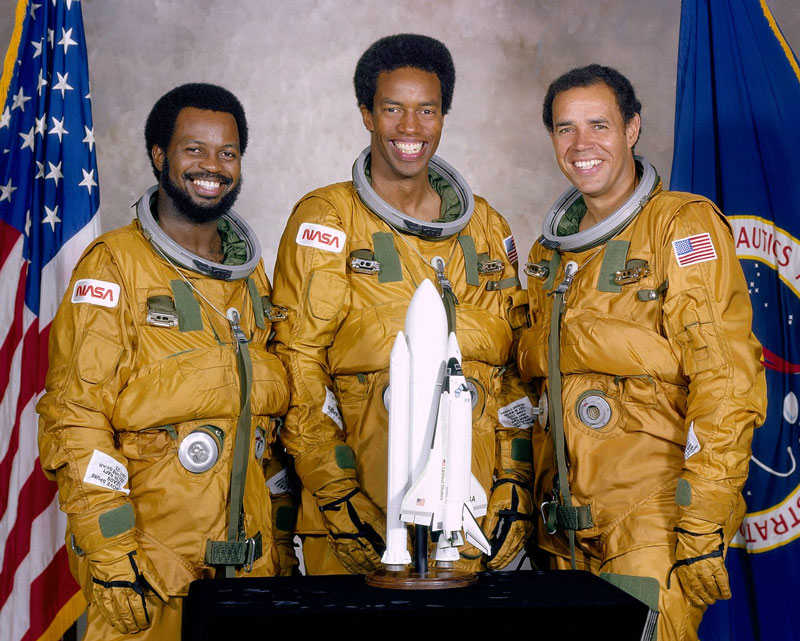DAY 14: SCIENCE PT1 – FROM PRACTICAL INGENUITY TO SCIENTIFIC DISCOVERY AND INNOVATION
I have heard it said, “you can take the enslaved person out of the plantation, but you can’t take the plantation out of the person.” This statement reflects some people’s attempt to identify the behavior, which can be viewed as unfavorable, forced upon Blacks by the experience of chattel slavery as a part of their core. This gross mischaracterization could not be further from the truth.
Indeed, it would take years to overcome the scarring left on both the minds and the psyche of those that endured such callous treatment. But let it be known, the wisdom and practical ingenuity that enslaved Africans used to help innovate farming processes and other life challenges did not leave their minds simply because they left the plantation. Any distorted self-perception instilled by the shackles and whips became quickly shattered by the immediate success of their focused educational efforts.
Some Blacks born in the North were fortunate enough to overcome imposed educational barriers and attend ivy league schools. Others cut their teeth in schools developed specifically for Blacks that later became known as Historically Black Colleges and Universities. Either way, #LetTheTruthBeTold, When the opportunity presented itself, Black’s hunger for education, their strong work ethic, and their innate desire to excel gave birth to an era of academic excellence.
One of the areas that Blacks were able to make dramatic contributions to was science. This section focuses on the innovators, ground-breakers, and world-renown analytical thinkers who left their mark on the scientific community, changing our nation as well as the world for ages to come. #LetTheTruthBeTold
We have chosen to celebrate a select few science pioneers for their determination to change the perception of Black peoples contributions and thus change the landscape and future of our country. Today we honor their genius. We must not let their efforts be forgotten or let others bask in the credit of their achievements. Today we change the narrative. #LET THE TRUTH BE TOLD.
“Prominent Black Scientist”
Black scientist have changed the trajectory of our lives forever. It is difficult in many instances to separate Black scientist from Black inventors but nevertheless, we celebrate their contributions.
“Black NASA Scientist”
THE HUMAN COMPUTER: MATHEMATICIAN AND SCIENTIST KATHERINE GOBLE JOHNSON (1918-2020)
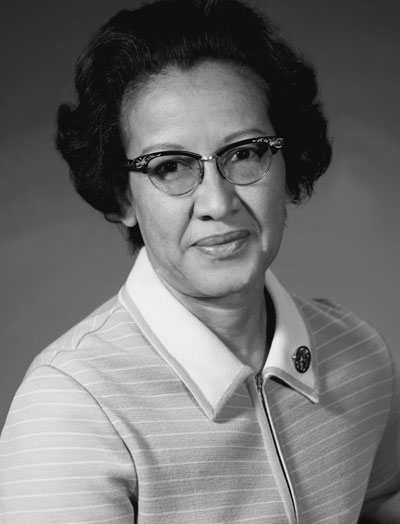
Katherine Johnson 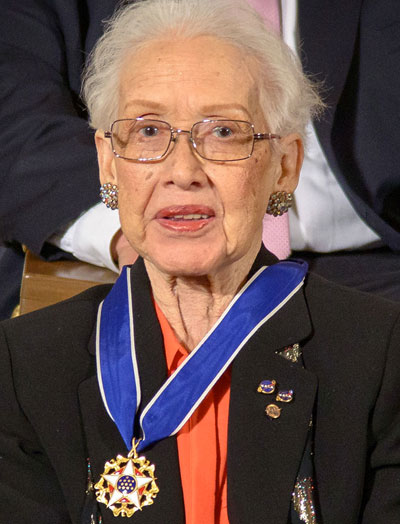
Presidential Medal of Freedom Recipient
Katherine Goble Johnson, heralded as the first African American woman in Aerospace Engineering, was born on August 26, 1918, in White Sulfur Springs, West Virginia, a city where schooling for “colored” people ended with the eighth grade. In 1937, she graduated summa cum laude (with highest distinction), with a Bachelor of Science in French and Mathematics, from West Virginia State University (formerly West Virginia State College). Twenty years later, married with three children, she transitioned from a teaching career to a coveted research mathematician position, at the National Advisory Committee for Aeronautics (NACA, 1915-1958), the predecessor to the National Aeronautics and Space Administration (NASA, 1958- ). Johnson’s mathematical prowess led her to assist NACA’s all-male team of engineers tasked with finding solutions to America’s space-flight navigation problems.
Born to Joshua and Joylette Coleman, Katherine’s father was a farmer and janitor who quit school after the sixth grade. He moved his family 125 miles from their White Sulfur Springs home to Institute, West Virginia so that Katherine and her older siblings, Charles, Margaret, and Horace, could attend school beyond the eighth grade. Her father returned home to work the farm while her mother, a former teacher, became a domestic worker and stayed with the children in Institute.
Coleman’s love for mathematics helped her excel in school. She skipped grades to start high school at ten, graduating at fourteen. In college, she was mentored by Dr. William Waldron Schieffelin Claytor, the third African American to earn a Ph.D. in mathematics. Claytor designed a special course in analytic geometry for her.
“Intimate Story of Dr. Christine Darden”
Dr. Christine Darden, an extraordinary black female NASA scientist featured in Hidden Figures.
“First Black Astronauts”
Mae C. Jemison was born on October 17, 1956 in Decatur, Alabama to Charlie and Dorothy Jemison. At the age of three, the family moved to Chicago, Illinois to further their educational opportunities. Her parents stressed the importance of education and when she was four, her uncle sparked her interest in archaeology and anthropology. She spent much of her time in libraries reading about all she could get her hands on. Mae graduated high school with honors and entered Stanford University (California) with an interest in the biomedical engineering profession. She graduated in 1977 with a degree in chemical engineering and later a second bachelor’s degree in African American studies.
Jemison then attended Cornell University’s medical school (New York) in 1977 and graduated in 1981. During her time at Cornell, she volunteered in a Thai refugee camp and took part in health studies in Kenya. From 1983 to 1985 she was the area Peace Corps medical officer for Sierra Leone and Liberia in West Africa. She also took part in various research projects for the vaccines for hepatitis B and rabies.
Early on, Jemison decided she wanted to be an astronaut and in 1987 she joined the National Aeronautics and Space Administration (NASA) program and completed a one year training program in 1988. Prior to her first flight in space, she worked at the Kennedy Space Center as a mission specialist. In September of 1992, Mae Jemison became the first African American woman in space during her flight on the STS-47, Spacelab-J. During this flight, she logged 190 hours, 30 minutes and 23 seconds in space. She resigned from NASA in 1993.
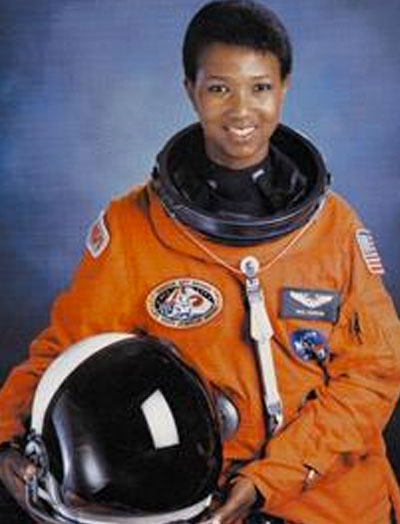
Dr. Mae C. Jemison 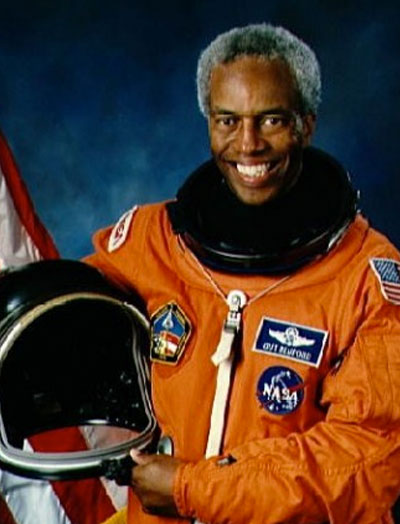
Dr. Guion S. Bluford Jr.
Guy Bluford, a member of the SDS-8 space shuttle Challenger crew in 1983, was the first African American in space. Born in Philadelphia, Pennsylvania, Bluford was interested in math and science and knew he wanted to work in aerospace engineering before graduating high school. His high school counselor suggested that college was not for him. Refusing the advice, Bluford became the only black engineering student at Pennsylvania State University in 1960. Undaunted, he graduated with a degree in aerospace engineering in 1964 and went through pilot training at Williams Air Force Base in Arizona where he received his pilot wings one year later. Before being sent to Vietnam in 1967, Bluford felt the sting of racial discrimination when his family was denied housing on base. He flew 144 combat missions with the 557th Squadron in Vietnam.
After serving his tour of duty in Vietnam, Bluford worked as a flight instructor at Sheppard Air Force Base in Texas and started graduate studies at the Air Force Institute of Technology in 1972. He received a M.S. in aerospace engineering in 1974 and a Ph.D. in 1978. The same year, he was one of the thirty-five selected for the National Aeronautics and Space Administration (NASA) astronaut training program out of 10,000 applicants.
On August 30, 1983, over a million people and more than 250 famous black educators and professionals including Dr. Dorothy Irene Height, President of the National Council of Negro Women, and C. Alfred Anderson who trained many of the Tuskegee Airmen, watched Bluford blast off into space. He flew the space shuttle, conducted experiments and helped launch a $45 million satellite to provide communications and weather information for India. President Ronald Reagan called the space shuttle during their mission and told Bluford “You will serve as a role model for so many others and be so inspirational.”
President Ronald Reagan called the space shuttle during their mission and told Bluford “You will serve as a role model for so many others and be so inspirational.”
BLACKPAST.COM
“Black Pioneers”
FIRST BLACK ASTRONAUTS IN SPACE: THE LAST FRONTIER.
It happened in 1959. A nine-year-old boy from South Carolina enters a library and asks for a book on arithmetic, but the librarian threatens to call the police if he doesn’t leave – we imagine that something very bad is said about him. The boy’s name is Ronald Erwin McNair, his name may ring a bell: he was the second African-American to travel into space.
McNair died in the tragic Challenger accident of 1986. It took the space shuttle 73 seconds to take off and explode into space; it took the astronaut 36 years of his life to overcome segregation, poverty and social stereotypes and to set foot in space.
His story is told in a new documentary to be screened Monday on the Smithsonian Channel, “Black in Space: Breaking the Color Barrier.” The film examines how the struggle for civil rights was waged not only on Earth but across the galaxy, as these cosmonauts overcame racism and hostility from some NASA members to be catapulted into outer space. A symbol of resistance for generations to come.
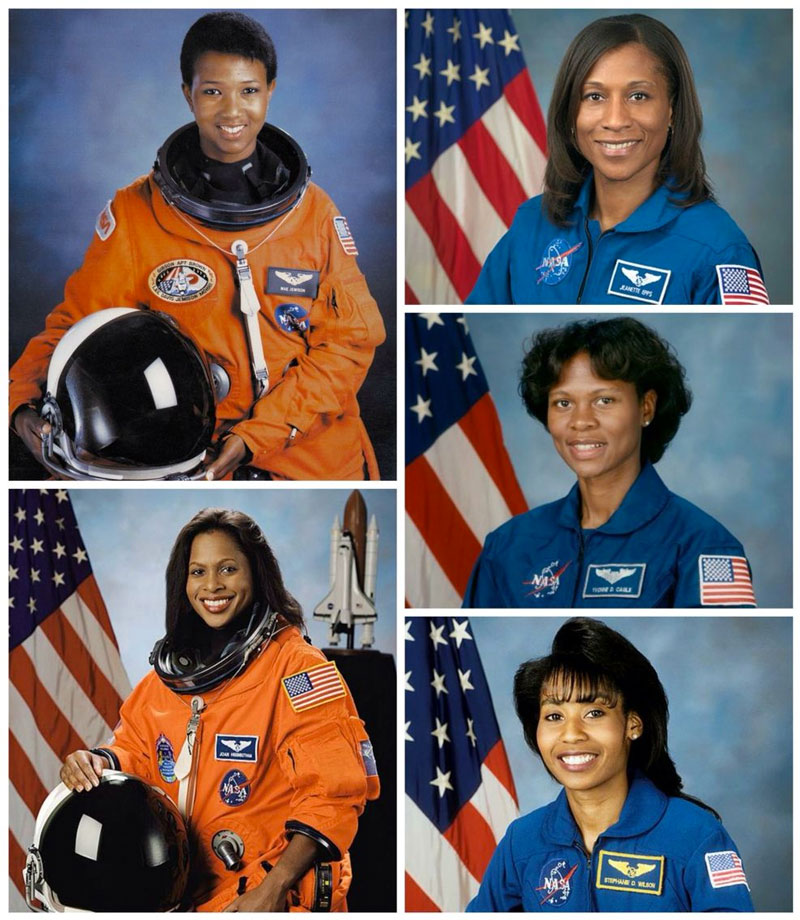
Black Woman Scientists and Astronauts, In order left to Right, top to Bottom, Mae Jemison, Jennette
Epps, Joan Higgenbotham, Yvonne Darlene Cagle, and Stephanie Wilson.
“18 African-American Astronauts”
It was 22 years after Alan Shepard’s first space trip that the U.S. sent a person of color up. After Ed Dwight’s journey to become the first African-American in space ended, Maj. Robert H. Lawrence Jr. was selected, on June 30, 1967, for the Department of Defense’s Manned Orbiting Laboratory program. But on Dec. 8 of that year, he was training another pilot when their F-104 Starfighter jet crashed at Edwards Air Force Base in California. Lawrence was killed.
When the Nixon administration canceled the program, many of the astronauts under the age of 35 — which Lawrence would have been — transferred to NASA, where they all went on to fly space shuttles. It would be 16 years after Lawrence fell from the sky before one of those shuttles would take an African-American beyond Earth.
At a ceremony honoring Lawrence 50 years after his death, Robert D. Cabana, the director of the Kennedy Space Center, said: “Major Lawrence truly was a hero. He took that first step setting the stage for what was to come.” These are the African-American men and women who came next.
Content provided courtesy of History.com, Britannica.com and Wikipedia.com, Biographies.com, Blackpast.com, notablebiographies.com, nytimes.com and aldiannews.com. All Rights Reserved.


